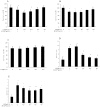A neuroendocrine mechanism of co-morbidity of depression-like behavior and myocardial injury in rats
- PMID: 24551098
- PMCID: PMC3923793
- DOI: 10.1371/journal.pone.0088427
A neuroendocrine mechanism of co-morbidity of depression-like behavior and myocardial injury in rats
Abstract
Depression is generally a recurrent psychiatric disorder. Evidence shows that depression and cardiovascular diseases are common comorbid conditions, but the specific pathological mechanisms remain unclear. The purpose of this study is to determine the effects of depression induced by chronic unpredictable mild stress (CUMS) on myocardial injury and to further elucidate the biological mechanism of depression. Rats were used as a model. The CUMS procedure lasted for a total of 8 weeks. After 4 weeks of CUMS, treated rats exhibited a reduced sucrose preference and changes in scores on an open field test, body weight and content of 5-HT in the brain as compared with the values of these variables in controls. These changes indicated depression-like changes in CUMS rats and demonstrated the feasibility of the depression model. In addition, pathological changes in the myocardium and increased cardiomyocyte apoptosis demonstrated that myocardial injury had occurred after 6 weeks of CUMS and had increased significantly by the end of 8 weeks of CUMS. Plasma serotonin (5-HT), norepinephrine (NE) and epinephrine (E), all depression-related neuroendocrine factors, were measured by HPLC-ECD techniques, and the content of plasma corticosterone (GC) was evaluated by an I(125)-cortisol radioactivity immunoassay in control and CUMS rats. The results indicated that 5-HT had decreased, whereas NE, E and GC had increased in CUMS rats, and these factors might be associated with depression-induced myocardial injury. The effects of 5-HT, NE and GC on the survival rate of cultured cardiomyocytes were determined using an orthogonal design. The results showed that 5-HT was a more important factor affecting cell survival than GC or NE. The results suggested that normal blood levels of 5-HT had a cytoprotective effect. The neuroendocrine disorders characterized by decreased 5-HT combined with increased GC and NE mediated the occurrence of depression-induced myocardial injury.
Conflict of interest statement
Figures




Similar articles
-
[The study of neuroendocrine mechanism of depression induced by chronic mild stress].Zhongguo Ying Yong Sheng Li Xue Za Zhi. 2006 May;22(2):169-72. Zhongguo Ying Yong Sheng Li Xue Za Zhi. 2006. PMID: 21162232 Chinese.
-
Resveratrol and dimethyl fumarate ameliorate depression-like behaviour in a rat model of chronic unpredictable mild stress.Brain Res. 2018 Dec 15;1701:227-236. doi: 10.1016/j.brainres.2018.09.027. Epub 2018 Sep 20. Brain Res. 2018. PMID: 30244113
-
Genipin is active via modulating monoaminergic transmission and levels of brain-derived neurotrophic factor (BDNF) in rat model of depression.Neuroscience. 2014 Sep 5;275:365-73. doi: 10.1016/j.neuroscience.2014.06.032. Epub 2014 Jun 24. Neuroscience. 2014. PMID: 24972301
-
Effects of EGCG on depression-related behavior and serotonin concentration in a rat model of chronic unpredictable mild stress.Food Funct. 2020 Oct 21;11(10):8780-8787. doi: 10.1039/d0fo00524j. Food Funct. 2020. PMID: 32955535
-
Comorbidity between depression and cardiovascular disease.Int Angiol. 2009 Apr;28(2):92-9. Int Angiol. 2009. PMID: 19367238 Review.
Cited by
-
Vortioxetine's Therapeutic Potential: Cardiac Responses to Chronic Unpredictable Mild Stress in a Rat Model.Arq Bras Cardiol. 2025 Feb 10;122(2):e20240159. doi: 10.36660/abc.20240159. eCollection 2025. Arq Bras Cardiol. 2025. PMID: 39936737 Free PMC article. English, Portuguese.
-
Effect of different charges of modified electroconvulsive seizure on the cognitive behavior in stressed rats: Effects of GluR1 phosphorylation and CaMKIIα activity.Exp Ther Med. 2019 Jan;17(1):748-758. doi: 10.3892/etm.2018.7022. Epub 2018 Nov 28. Exp Ther Med. 2019. PMID: 30651859 Free PMC article.
-
The Role of Chronic Stress in the Pathogenesis of Ischemic Heart Disease in Women.Compr Physiol. 2025 Feb;15(1):e70000. doi: 10.1002/cph4.70000. Compr Physiol. 2025. PMID: 39903543 Free PMC article. Review.
-
AMELIORATIVE EFFECT OF VORTIOXETINE IN EXPERIMENTAL MODEL OF ENDOCRINE PANCREAS DAMAGE RELATED TO CHRONIC UNPREDICTABLE MILD STRESS: AN IMMUNOHISTOCHEMICAL STUDY.Acta Endocrinol (Buchar). 2024 Jul-Sep;20(3):269-276. doi: 10.4183/aeb.2024.269. Epub 2025 May 23. Acta Endocrinol (Buchar). 2024. PMID: 40530100 Free PMC article.
-
Hypothalamic-pituitary-adrenal axis hypersensitivity in female rats on a post-weaning high-fat diet after chronic mild stress.Exp Ther Med. 2017 Jul;14(1):439-446. doi: 10.3892/etm.2017.4498. Epub 2017 May 23. Exp Ther Med. 2017. PMID: 28672951 Free PMC article.
References
-
- Murray CJL, Lopez AD (1997) Mortality by cause for eight regions of the world: Global Burden of Disease Study. The Lancet 349: 1269–1276. - PubMed
-
- Penninx BWJH, Beekman ATF, Honig A, Deeg DJH, Schoevers RA, et al. (2001) Depression and cardiac mortality: results from a community-based longitudinal study. Archives of General Psychiatry 58: 221. - PubMed
Publication types
MeSH terms
Substances
LinkOut - more resources
Full Text Sources
Other Literature Sources
Medical
Miscellaneous

